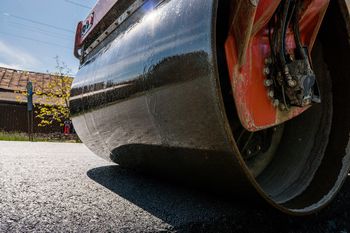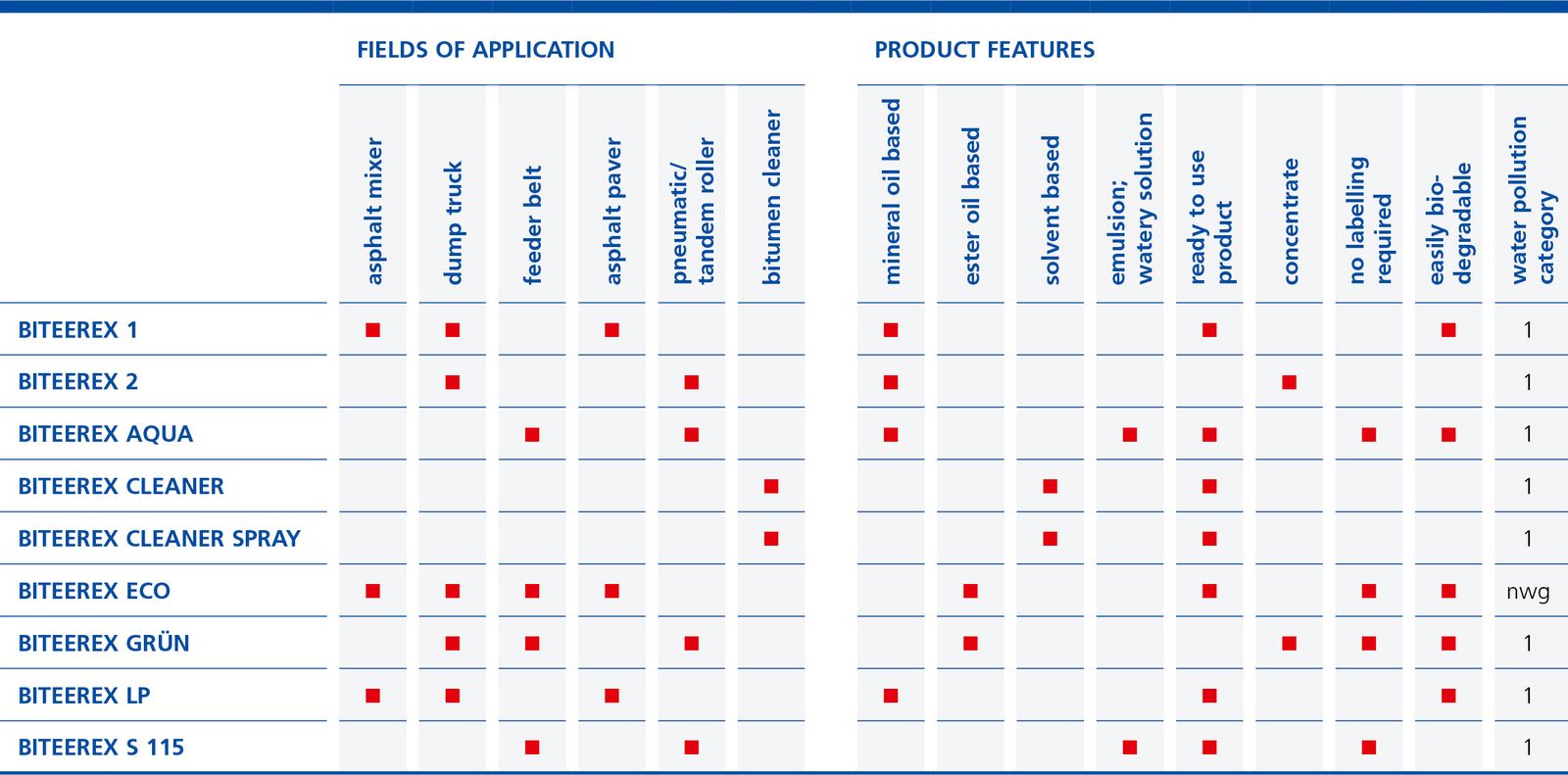Concrete release agents and bitumen release agents

Concrete release agents
High-quality concrete release agents are indispensable where the quality of a concrete surface is concerned. Based on our decades of experience, we have developed our high-performance SOK products in close cooperation with our customers. Today, these concrete release agents are utilised successfully around the world in precast plants as well as in structural and civil engineering.
Requirements for modern concrete release agents:
- Easy separation of concrete and formwork
- Concrete surfaces without pores and shrink holes
- Light-colored concrete surfaces without discoloration
- Clean formwork
- Protection of the formwork and easy cleaning
- Temporary protection against corrosion on steel formwork
- Hygienic safety for the user
- Harmlessness for the environment
- Universal applicability
- Cost effectiveness
- Sustainability
The fact that we can provide eco-friendly, alternative waterbased products, as concrete release agents for almost all applications clearly displays and proves that quality, efficiency and environmental awareness can be reconciled.
Our product range is also constantly evolving through our close cooperation with those people who utilise our products. Continuous dialogue with our customers is important to us. This close cooperation, coupled with our years of experience in the field of release agents, ensures that we can continue to provide ongoing product optimisation for you. In case of sufficient quantities, we will develop concrete release agents for your specific applications and requirements. Please contact us!

The composition of concrete release agents
Concrete release agents consist of a base fluid in which the required additives are dissolved. This base fluid can be mineral oil with and without de-aromatised white spirit, ester/vegetable oil or, in the case of emulsions, water. Fatty acids and/or esters are usually used as separating substances. The fatty acids react chemically with the cations of the “concrete water” to produce metal soaps, which form the “predetermined breaking point” between concrete and formwork following the hardening of the concrete. The often utilised esters are saponified to form fatty acids and alcohol by the highly alkaline concrete (pH value 12.9). The fatty acids react, as described, with the cations in the “concrete water”. The alcohol is built into the cement matrix. Furthermore the concrete release agents contain additives for the minimisation of pores and shrink holes as well as a temporary corrosion protection for steel formwork.
Product | Group 1Mineral oil basis, | Group 2Emulsions | Group 3Ester-oil release agent |
| Carrier substance | Mineral oils / partly with solvents (approx. 80 to 95%) | Water (approx. 65 to 85%) | Vegetable oils, ester oils (approx. 95 to 99%) |
| Chemically separating substance | Fatty acids and esters (approx. 2 to 15%) | Fatty acids and esters | Vegetable oils, esters (approx. 95 to 99%) |
| Additives for minimising pores and shrink holes | yes | yes | yes |
| Corrosion protection additives | yes | yes | yes |
| Other additives | - | Emulsifying agents | - |
Types of concrete release agents and their applications
Mineral oil based release agents

Concrete release agents based on mineral oils with and without solvents are still widely used in precast plants and in structural and civil engineering. These products are universally applicable. Precast plants often utilise solvent-based products for standard formwork to fulfil the high demands on the quality of concrete surfaces (up to exposed concrete class “SB4”) and cleanliness of the formwork. The products containing mineral oil are often also used as immediate demolding release agents. According to the dangerous and hazardous substances regulations, solvent-based products must be labelled.
Your benefits at a glance:
- Application temperature up to 130°
- Reduce pore and shrink holes formation to a large extent
- Provide clean and homogeneous concrete surfaces
- Contain an effective corrosion protection
- Do not impair the adhesion of plaster, adhesives and paint
- Suitable for use in horizontal and vertical areas
Emulsion based release agents

For reasons of health and safety at work and environmental hygiene, water-based products are increasingly used in stationary production plants. Emulsions which are utilised as concrete release agents are the latest product generation. The emulsions can be used in precast plants on all standard formwork such as steel formwork, plastic-coated wooden formwork etc. Compared with solvent-based concrete release agents, emulsions have distinct advantages thanks to their handling and application. Emulsions from the SOK AQUA range are non-flammable and virtually odourless during spraying. The effects of the SOK AQUA products in terms of concrete technology correspond in most cases to the concrete release agents containing solvents. The user therefore obtains flawless exposed concrete surfaces that are free of pores, shrink holes and stains. The concrete surfaces are bright and smooth. Furthermore, the formwork can be easily cleaned without too much effort.
FUCHS LUBRITECH has successfully managed to integrate a demonstrably increased corrosion protection in some products, for example, SOK AQUA KS for utilisation on corrodible steel formwork.
Your benefits at a glance:
- Application temperature up to 70 °C (formwork temperature)
- Largely prevent pore formation
- Provide clean and uniform surfaces
- Contain very effective corrosion protection for steel formwork
- Do not impair the adhesion of plaster, adhesives or paint
- Suitable for use in horizontal and vertical areas
- Non-flammable
- Almost odourless in the application
- Easily biodegradability
Ester or vegetable oil based release agents

Biogenic release agents based on ester or vegetable oil are not only suitable for applications in drinking water protection areas but can also be used in many other areas. Due to their partially high viscosity, these products can only be used to a limited extent in winter operation.
Products based on ester oil, which also include vegetable oils, are becoming more and more important for environmental reasons and are increasingly used for the production of precast concrete elements. These products are mainly found in pipe production and mixer protection, but also in the production of concrete sleepers or L-stones and the immediate demolding. FUCHS LUBRITECH has developed SOK ECO 911, SOK ECO 107 and SOK HU ECO for requirements of this kind.

Contact us
Phone:
(+40) 21 232 0942
E-mail:
office@fuchs.com
Video tutorial: application of concrete release agents

Bitumen and asphalt release agents
The production and processing of asphalt can get very dirty. The bitumen obtained from petroleum, which serves as a binding agent between various aggregates in the asphalt, is not water-soluble and can cause considerable contamination on surfaces that come into contact with the sticky mass.
Because machines and devices contaminated with bitumen are very difficult to clean, they should be pre-treated before they are used. This is where asphalt release agents come into play, which protect the surfaces from contamination in order to ensure the longevity of the equipment that is used in asphalt production and road construction.
Requirements for asphalt release agents
- Good separating effect between bitumen/asphalt and machine surfaces
- Reduction of the cleaning effort to a minimum
- Good adhesion to vertical surfaces
- Universally applicable with different asphalt mixtures
- No negative effect on the asphalt properties
- Corrosion protection of machine and vehicle surfaces
- Harmless for the user and the environment

Use of asphalt release agents
Even today, diesel is occasionally used as a release agent in practice. However, this affects the structural integrity of the applied asphalt in the pavement. In addition, diesel poses a serious threat to the environment. Modern asphalt release agents are not only environmentally friendly - they are also harmless to users and when using various types of asphalt, such as B. mastic asphalt or stone mastic.
Typical areas of application
- Asphalt mixers / asphalt mixing plants
- Truck beds
- Feeder belts
- Asphalt pavers
- Pneumatic rollers and tandem rollers with steel surfaces
- Other devices and tools that come into contact with hot asphalt
How should asphalt release agents be used?
Before applying the asphalt release agents, the surfaces to be treated must be completely clean. When applying with a spray device, make sure that an oil-resistant hose is used and that the pressure is between 4 and 6 bar. A flat jet nozzle made of stainless steel is recommended. The release agent can also be applied thinly and evenly with a brush.
BITEEREX – Asphalt release agents from FUCHS LUBRITECH
With the BITEEREX series, FUCHS LUBRITECH offers an extensive portfolio that has the right asphalt release agent for every application. The BITEEREX range includes release agents with various base oils (mineral oil or vegetable oils), emulsions and concentrates. Some of our asphalt release agents do not require labeling and are rapidly biodegradable.

Even for stubborn bitumen, asphalt or wax residues we offer BITEEREX CLEANER, a reliable cleaner.
Feel free to contact us and describe your application. We will provide you with a suitable solution!

